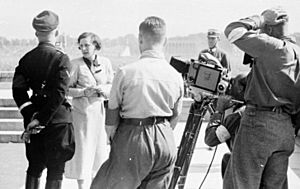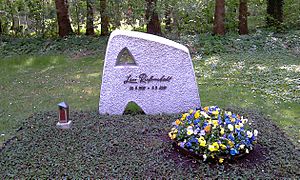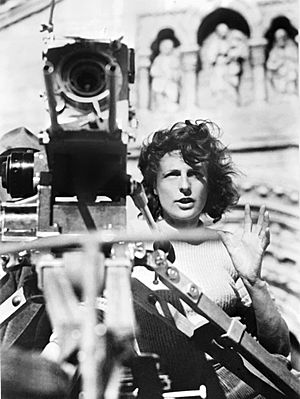Leni Riefenstahl facts for kids
Quick facts for kids
Leni Riefenstahl
|
|
|---|---|
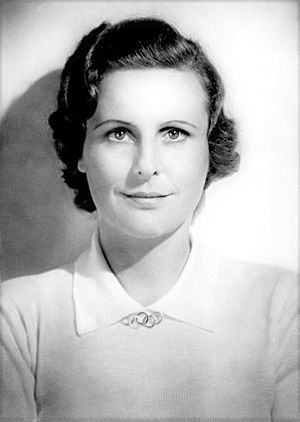
Riefenstahl in a 1930s postcard honoring her for the propaganda film Olympia
|
|
| Born |
Helene Bertha Amalie Riefenstahl
22 August 1902 |
| Died | 8 September 2003 (aged 101) |
| Resting place | Munich Waldfriedhof |
| Citizenship | Germany; Sudan |
| Occupation | Film director, producer, screenwriter, photographer, actress |
| Years active | 1925–2002 |
| Known for | Triumph of the Will Olympia |
| Spouse(s) |
Eugen Karl "Peter" Jacob
(m. 1944; div. 1946) |
| Partner(s) | Horst Kettner (1968–2003) |
| Signature | |
Helene Bertha Amalie "Leni" Riefenstahl (22 August 1902 – 8 September 2003) was a German film director, photographer, and actress. She became famous for her movies, especially those made for the Nazi Party in Germany.
Leni Riefenstahl was a talented swimmer and artist from a young age. She also loved dancing and performed across Europe. After seeing a movie poster in 1924, she decided to become an actress. Between 1925 and 1929, she starred in five successful films.
In 1932, Riefenstahl became one of the few women in Germany to direct a film. She directed her own movie called Das Blaue Licht ("The Blue Light"). In the 1930s, she directed two well-known Nazi propaganda films: Triumph des Willens ("Triumph of the Will") and Olympia. These films brought her worldwide attention and praise. They are still seen as very effective and technically advanced films.
However, her work on Triumph des Willens greatly harmed her career and reputation after World War II. She worked closely with Adolf Hitler on these films and they became friends. After the war, Riefenstahl was arrested. She was found to have supported the Nazis, but she was not charged with war crimes. For the rest of her life, she said she didn't know about the Holocaust. She was sometimes criticized for this. Later in life, Riefenstahl wrote an autobiography and published photography books about the Nuba peoples in Africa.
Contents
Early Life and Interests
Helene Bertha Amalie Riefenstahl was born in Berlin, Germany, on August 22, 1902. Her father, Alfred Riefenstahl, owned a successful heating company. He wanted Leni to join the family business.
However, Leni's mother, Bertha, believed in her daughter's artistic talents. Leni was the only child for many years. She loved art from a young age, painting and writing poetry at four. When she was twelve, she joined a gymnastics and swimming club.
In 1918, at age 16, Leni saw a show of Snow White. This made her want to become a dancer. Her father preferred a more traditional career for her. But her mother secretly enrolled her in dance classes in Berlin. Leni quickly became a top student there.
Dancing and Acting Careers
Leni Riefenstahl became well-known for her unique dance style. She traveled across Europe, performing in shows. She earned a good income from dancing and didn't think about filmmaking at all.
However, she suffered several foot injuries, which led to knee surgery. This threatened her dancing career. While going to a doctor's appointment, she saw a poster for a 1924 film called Mountain of Destiny. This inspired her to try filmmaking. She started watching many movies and attending film events.
Leni met Luis Trenker, an actor from Mountain of Destiny. Through a friend, she also met Arnold Fanck, the director of that film. Fanck was a pioneer of "mountain films." Leni admired his work and convinced him of her acting skills. She persuaded him to cast her in one of his films.
She later received the script for Fanck's 1926 film, The Holy Mountain. She made several films with Fanck, learning about acting and film editing. One of her most famous films with Fanck was The White Hell of Pitz Palu in 1929. This film made her famous outside Germany.
In 1932, Riefenstahl directed and produced her own film, Das Blaue Licht ("The Blue Light"). This film won an award at the Venice Film Festival. In the movie, Riefenstahl played an innocent peasant girl. She was disliked by villagers but protected by a glowing mountain cave.
Riefenstahl said she was invited to Hollywood to make films. But she chose to stay in Germany. Adolf Hitler was a fan of Das Blaue Licht. He thought Riefenstahl represented the ideal German woman. He saw her talent and arranged a meeting with her.
In 1933, Riefenstahl also acted in two films made by American and German companies. These were SOS Eisberg (German) and S.O.S. Iceberg (English). Her role in S.O.S. Iceberg was her only English-speaking film role.
Directing Career
Propaganda Films
In 1932, Riefenstahl heard Adolf Hitler speak at a rally. She was very impressed by his speaking skills. In her autobiography, she described it as a powerful, unforgettable experience.
Hitler was very interested in Riefenstahl's work. He felt she fit his idea of an "Aryan" woman. He had seen her performance in Das Blaue Licht. After meeting Hitler, Riefenstahl was asked to direct Der Sieg des Glaubens ("The Victory of Faith"). This was an hour-long film about a Nazi rally in 1933.
Riefenstahl was surprised by the offer. Hitler had ordered his Propaganda Ministry to give her the job. She agreed to direct the film, even with little time to prepare. She and Hitler got along well and became friends. The Nazi Party paid for the film.
Hitler then asked her to film Triumph des Willens ("Triumph of the Will"). This was a new propaganda film about the 1934 party rally in Nuremberg. Over a million Germans took part in this rally. This film is often considered one of the greatest propaganda films ever made.
Riefenstahl said she first didn't want to make more Nazi Party films. She wanted to direct a feature film called Tiefland. Hitler convinced her to film Triumph des Willens. She said she agreed only if she wouldn't have to make more party films. Triumph des Willens made her even more famous internationally.
In a 1993 documentary, Riefenstahl strongly denied trying to create Nazi propaganda. She said she was upset that Triumph des Willens was used that way.
Despite her promise, Riefenstahl made another film about the Nazi Party in 1935. It was a 28-minute film called Tag der Freiheit: Unsere Wehrmacht ("Day of Freedom: Our Armed Forces"). This film was about the German Army and was also filmed at the Nuremberg rally. Riefenstahl said she made it to show the army, which felt left out of Triumph des Willens.
Hitler then invited Riefenstahl to film the 1936 Summer Olympics in Berlin. Riefenstahl said the International Olympic Committee asked her to make this film. She traveled to Greece to film the first torch relay and the original Olympic site. This footage became Olympia. This film was very successful and praised for its technical and artistic achievements. The Nazis secretly funded Olympia.
Riefenstahl was one of the first filmmakers to use tracking shots in a documentary. She put cameras on rails to follow athletes. The film also used slow-motion shots. She experimented with underwater diving shots, high and low angles, and aerial shots. Many of these techniques were new at the time. Her use of them set a standard for modern sports photography. Riefenstahl filmed athletes of all races, including African-American Jesse Owens.
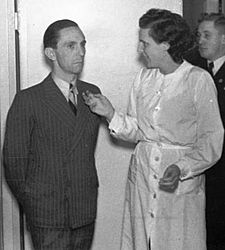
Olympia premiered for Hitler's 49th birthday in 1938. Its international release led Riefenstahl to tour America. In 1937, she told a reporter, "To me, Hitler is the greatest man who ever lived." She arrived in New York City in November 1938, just after Kristallnacht (a violent attack against Jews). When news of this reached the U.S., Riefenstahl publicly defended Hitler. She met Henry Ford and Walt Disney during her tour.
From the diaries of Joseph Goebbels, the Nazi propaganda minister, we know Riefenstahl was friendly with him and his wife. Riefenstahl claimed Goebbels was jealous of her influence on Hitler. She said his diary entries couldn't be trusted.
World War II and Later Films
When Germany invaded Poland in September 1939, Riefenstahl was there as a war correspondent. She was photographed in a military uniform with German soldiers. In the town of Końskie, 30 civilians were killed. Riefenstahl said she tried to help but was threatened by a German soldier. She also said she didn't know the victims were Jewish. Photographs show her looking upset that day. By October 1939, she was back in Poland, filming Hitler's victory parade in Warsaw. After this, she stopped making Nazi-related films.
On June 14, 1940, when German troops entered Paris, Riefenstahl sent a telegram to Hitler. She wrote about her "indescribable joy" and "burning gratitude" for Germany's victory. She later explained that everyone thought the war was over then. Riefenstahl was friends with Hitler for 12 years. However, their friendship weakened in 1944 after her brother died on the Russian Front.
After her propaganda films, Riefenstahl started working on Tiefland again. The German government paid her a large sum for it. From 1940 to 1944, she filmed parts of Tiefland. For extras, she used Romani people who were held in internment camps. These people were mistreated on set. After filming, many were sent to the Auschwitz death camp.
Riefenstahl always said that all the film extras survived. However, a German court ruled that she knew the extras were from a concentration camp. But they also agreed she wasn't told the Romani would be sent to Auschwitz. In 2002, at age 100, Riefenstahl apologized to a Romani group. She said, "I regret that Sinti and Roma [people] had to suffer during the period of National Socialism."
Tiefland was finally released in 1954. It was her last feature film. Most of Riefenstahl's unfinished projects were lost during the war. The French government took her editing equipment and film reels. After legal battles, they were returned, but some film was damaged.
Later Career Challenges
Riefenstahl tried to make more films in the 1950s and 1960s. But she faced strong public protests and criticism. Many filmmakers who had fled Nazi Germany were not supportive of her. Even with willing investors, most of her projects stopped due to negative publicity about her past.
In the 1960s, Riefenstahl became interested in Africa. She visited Kenya and Sudan. She photographed Nuba tribes and lived with them to learn about their culture. She tried to make a film about modern slavery, but it was never finished. She did sell her photos to magazines worldwide. She even received Sudanese citizenship for her work there.
Detention and Trials
After World War II, Leni Riefenstahl was arrested by American troops. She was held in various prison camps across Germany from 1945 to 1948. She was also under house arrest for a time.
She was tried four times by authorities after the war. She was found to be a "fellow traveller" (Mitläufer), meaning she sympathized with the Nazis. She was never an official Nazi Party member. But she was always linked to them because of her propaganda films. Over the years, she won more than fifty lawsuits against people who accused her of being involved in Nazi crimes.
Riefenstahl said her biggest regret was meeting Hitler. She stated, "It was the biggest catastrophe of my life. Until the day I die people will keep saying, 'Leni is a Nazi', and I'll keep saying, 'But what did she do?'"
Shortly before she died, Riefenstahl said in a BBC interview, "I was one of millions who thought Hitler had all the answers. We saw only the good things; we didn't know bad things were to come."
Africa, Photography, Books, and Final Film
Leni Riefenstahl began a lifelong partnership with her cameraman, Horst Kettner. He was 40 years younger than her. They were together from when she was 60 and he was 20.
Riefenstahl's books with photos of the Nuba tribes were published in 1974 and 1976. They were called Die Nuba and Die Nuba von Kau. Some critics said her photos showed "fascist aesthetics." However, others praised her work.
Riefenstahl also photographed the 1972 Summer Olympics in Munich. She photographed rock star Mick Jagger and his wife, Bianca. Later, she photographed entertainers Siegfried & Roy in Las Vegas. She was a special guest at the 1976 Summer Olympics in Montreal, Canada.
In 1978, Riefenstahl published a book of her underwater photographs called Korallengärten ("Coral Gardens"). This was followed by Wunder unter Wasser ("Wonder under Water") in 1990. On her 100th birthday, August 22, 2002, she released her last film. It was called Impressionen unter Wasser ("Underwater Impressions"). This film was about life in the oceans. Riefenstahl was a member of Greenpeace for eight years. She even lied about her age to get certified for scuba diving.
In 2000, Riefenstahl survived a helicopter crash in Sudan. She was trying to find out what happened to her Nuba friends during a civil war. She was flown to a hospital in Munich for treatment.
Death
Leni Riefenstahl celebrated her 101st birthday on August 22, 2003. She became ill the day after her birthday party.
Riefenstahl had been suffering from cancer for some time. Her health quickly worsened in her last weeks. Horst Kettner said in 2002 that she was in great pain and very weak. Riefenstahl died in her sleep on September 8, 2003, at her home in Pöcking, Germany. After her death, many publications recognized her important technical achievements in filmmaking.
Leni Riefenstahl's former secretary and only heir, Gisela Jahn, donated Riefenstahl's belongings to a cultural foundation. These included photos, films, letters, and documents from the 1920s onwards.
Film Biographies
In 1993, a German documentary film was made about Riefenstahl. It was called The Wonderful, Horrible Life of Leni Riefenstahl. Ray Müller directed it. Riefenstahl appeared in the film and answered many questions. She talked about her life and filmmaking career. The film was nominated for seven Emmy Awards and won one. Riefenstahl cooperated with the documentary to share her life story.
Müller also made a 2000 documentary called Leni Riefenstahl: Her Dream of Africa. This film was about her return to Sudan to visit the Nuba people.
In 2000, actress Jodie Foster planned to make a movie about Riefenstahl. This caused protests because Riefenstahl was seen as linked to Hitler's inner circle. The project did not get Riefenstahl's approval before she died. She reportedly wanted Sharon Stone to play her, not Foster.
In 2011, director Steven Soderbergh said he had also worked on a film about Riefenstahl. But he stopped the project due to concerns about how well it would do.
Filmography
As Actress
- 1925: Wege zu Kraft und Schönheit ("Ways to Strength and Beauty") as Dancer
- 1926: Der heilige Berg ("The Holy Mountain") as Diotima
- 1927: Der große Sprung ("The Great Leap") as Gita
- 1928: Das Schicksal derer von Habsburg ("Fate of the House of Habsburg") as Maria Vetsera
- 1929: Die weiße Hölle vom Piz Palü ("The White Hell of Pitz Palu") as Maria Maioni
- 1930: Stürme über dem Mont Blanc ("Storm Over Mont Blanc") as Hella Armstrong
- 1932: Das blaue Licht ("The Blue Light") as Junta
- 1933: S.O.S. Eisberg ("S.O.S. Iceberg") as Hella, seine Frau
- 1954: Tiefland ("Lowlands") as Martha, a Spanish dancer (final film role)
As Director
- 1932: Das blaue Licht ("The Blue Light")
- 1933: Der Sieg des Glaubens ("The Victory of Faith")
- 1935: Triumph des Willens ("Triumph of the Will")
- 1935: Tag der Freiheit: Unsere Wehrmacht ("Day of Freedom: Our Armed Forces")
- 1937: Wilde Wasser ("Wild Water")
- 1938: Olympia
- 1954: Tiefland ("Lowlands")
- 1965: Allein unter den Nuba ("Alone Among the Nuba") (Unreleased)
- 2002: Impressionen unter Wasser ("Impressions under Water")
Books
- Riefenstahl, Leni (1973). Die Nuba. ISBN 978-0-312-13642-0.
- Riefenstahl, Leni (1976). Die Nuba von Kau. ISBN 978-0-312-16963-3.
- Riefenstahl, Leni (1978). Korallengärten. ISBN 978-0-06-013591-1.
- Riefenstahl, Leni (1982). Mein Afrika. ISBN 978-0-517-54914-8.
- Riefenstahl, Leni (1987). Leni Riefenstahl's Memoiren. ISBN 978-3-8228-0834-4.
- Riefenstahl, Leni (1990). Wunder unter Wasser. ISBN 978-3-7766-1651-4.
- Riefenstahl, Leni (1995). Leni Riefenstahl: a memoir. New York: Picador. ISBN 9780312119263.
- Riefenstahl, Leni (2002). Africa. ISBN 978-3-8228-1616-5.
- Riefenstahl, Leni (2002). Riefenstahl Olympia. ISBN 978-3-8228-1945-6.
Images for kids
See also
 In Spanish: Leni Riefenstahl para niños
In Spanish: Leni Riefenstahl para niños


